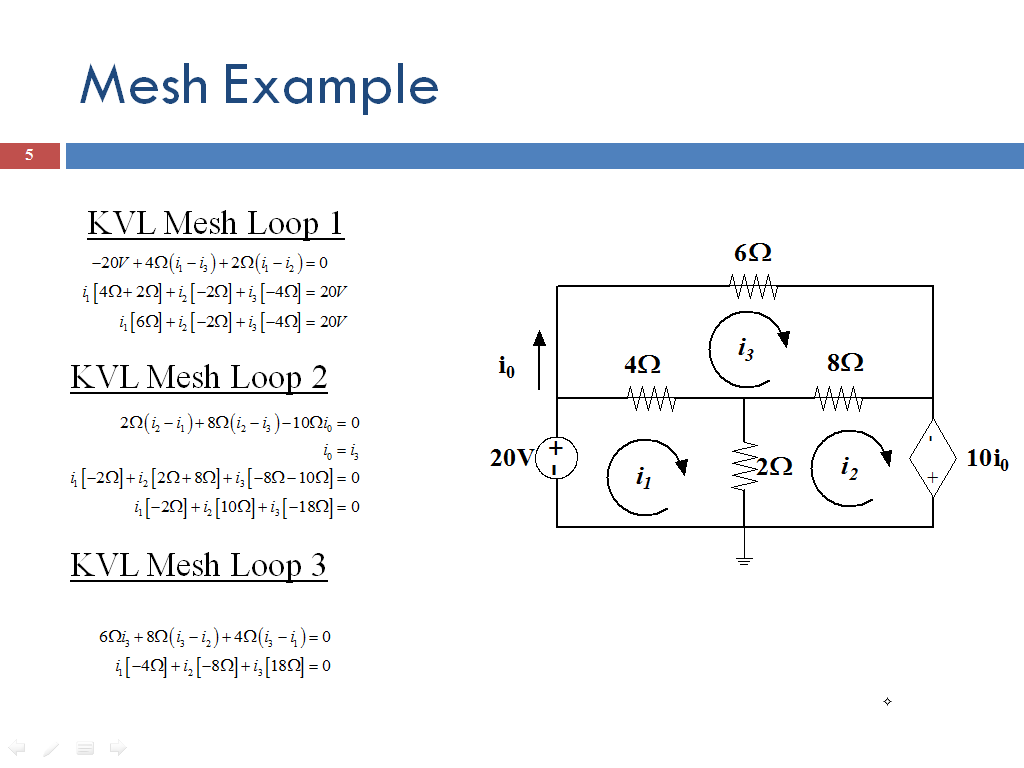Super Position Theorem
the basic concept of superposition is to analyze the circuit, one source at a time. by using the superposition in the circuit we remove all the independent sources except one and analyze the circuit for that source.
To apply the superposition theorem to calculate the current through resistor R1 in the two loop circuit shown. the individual current supplied by each battery is calculated with the other battery replaced by a short circuit.

- the strategy used in the Superposition Theorem is to eliminate all but one source of power within a network at a time, using series/parallel analysis to determine voltage drops (and/or currents) within the modified network for each power source separately. Then, once voltage drops and/or currents have been determined for each power source working separately, the values are all “superimposed” on top of each other (added algebraically) to find the actual voltage drops/currents with all sources active.
Example:


- Since we have two sources of power in this circuit, we will have to calculate two sets of values for voltage drops and/or currents, one for the circuit with only the 28 volt battery in effect and one for the circuit with only the 7 volt battery in effect:

- When re-drawing the circuit for series/parallel analysis with one source, all other voltage sources are replaced by wires (shorts), and all current sources with open circuits (breaks). Since we only have voltage sources (batteries) in our example circuit, we will replace every inactive source during analysis with a wire.
- Analyzing the circuit with only the 28 volt battery, we obtain the following values for voltage and current:


- Analyzing the circuit with only the 7 volt battery, we obtain another set of values for voltage and current:


- When superimposing these values of voltage and current, we have to be very careful to consider polarity (voltage drop) and direction (electron flow),
- Applying these superimposed voltage figures to the circuit, the end result looks something like this.

- Currents add up algebraically as well, and can either be superimposed as done with the resistor voltage drops, or simply calculated from the final voltage drops and respective resistances (I=E/R). Either way, the answers will be the same.

Process of using Superposition
- First of all make sure the circuit is a linear circuit; or a circuit where Ohm’s law implies, because Superposition theorem is applicable only to linear circuits and responses.
- Replace all the voltage and current sources on the circuit except for one of them.While replacing a Voltage source or Current Source replace it with their internal resistance or impedance. If the Source is an Ideal source or internal impedance is not given then replace a Voltage source with a short ; so as to maintain a 0 V potential difference between two terminals of the voltage source. And replace a Current source with an Open ; so as to maintain a 0 Amps Current between two terminals of the current source.
- Determine the branch responses or voltage drop and current on every branches simply by using KCL , KVL or Ohm’s Law.
- Repeat step 2 and 3 for every source the circuit have.
- Now algebraically add the responses due to each source on a branch to find the response on the branch due to the combined effect of all the sources.
Some Learnings:
- The Superposition Theorem states that a circuit can be analyzed with only one source of power at a time, the corresponding component voltages and currents algebraically added to find out what they'll do with all power sources in effect.
- To negate all but one power source for analysis, replace any source of voltage (batteries) with a wire; replace any current source with an open circuit.













 For example, for the node to the right KCL yields the equation:
For example, for the node to the right KCL yields the equation:












